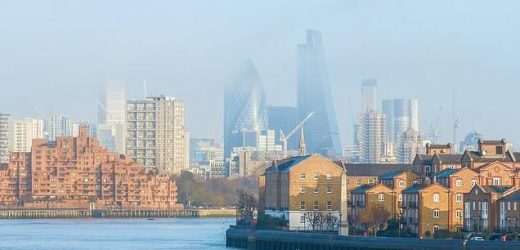Air pollution increases children’s risk of mental health conditions in adulthood ‘as much as exposure to LEAD’, study warns
- Study of 2,000 Britons looked at impact of air pollution on mental health
- Found ‘modest’ link between childhood exposure and adult mental health issues
- Researchers looked specifically at elevated NOx and PM2.5 levels in the UK
- Found 22% live in areas where NOx exceeds WHO guidelines, with 84% above the safety threshold for PM2.5
Children who grow up in cities with dirty air and high levels of air pollution are more likely to suffer mental health issues as adults, a study has found.
Researchers say the detrimental impact of a toxic atmosphere is similar to that of lead exposure.
Pollutants such as nitrogen oxides (NOx) and small carbon particles, called PM2.5, are spewed out by engines, industry, wood-burning stoves and farming.
These chemicals are increasingly being linked to health concerns such as asthma, an inhibited immune system and decreased lung damage, with around 36,000 deaths in England every year linked to air pollution.
Scroll down for video
Children who grow up in areas with high levels of air pollution are more likely to suffer mental health issues as adults, a study has found (stock)
Air pollution from fossil fuels is TWICE as deadly as thought
Air pollution created by the burning of fossil fuels like diesel and coal is responsible for one in five deaths globally every year, roughly 8.7million, new research reveals.
Around 17 per cent of deaths in the UK, 99,000 people a year, are due to air pollution exposure, data from UCL and Harvard University shows.
People living in industrialised areas and urban metropolises — such as South-East Asia, Eastern America and Europe — were exposed to the highest levels of pollution.
Research also shows half of all annual deaths linked to air pollution from fossil fuels occur in China and India.
Researchers from Duke University in North Carolina studied several decades of data from a study on more than 2,000 Britons and looked at how the levels of pollution affected mental health.
They found a link between childhood exposure and mental illness at age 18.
Study author Aaron Reuben, a graduate student in clinical psychology, says the data reveals a modest, but clear, association.
‘[But] because harmful exposures are so widespread around the world, outdoor air pollutants could be a significant contributor to the global burden of psychiatric disease,’ he said.
The effect of air pollution was found to be as strong as childhood exposure to lead, but weaker than a family history of the condition.
A person’s exposure to nitrogen dioxide and PM2.5 was determined by using their home address and looking at pollution levels on a nationwide database.
Mental health was assessed via interviews with experts using a measure known as psychopathology factor (p-factor).
Almost one in four (22 per cent) people were found to live in areas with levels of nitrogen oxides (NOx) above the WHO guideline of 10 micrograms per cubic metre of air (µg/m3).
Professor Kevin McConway, Emeritus Professor of Applied Statistics at the Open University, was not involved with the study and says the findings do show a clear link. However, he adds the research does not prove air pollution is the cause of the mental illness.
‘But, if the association does turn out to be one of cause and effect, air pollution could still be important in psychiatric public health, simply because so many people are exposed to air pollution levels above current guidelines,’ he said.
‘So, while this single study can’t give clear evidence on exactly what kind of association there is between poor air quality and mental health, it’s yet another potential reason for being concerned about air pollution levels.’
Millions of children and young people live in areas of England where air pollution law has been breached, figures from the Labour Party suggest.
More than 19,000 schools, colleges and nurseries are in local authority areas with illegal levels of air pollution, and more than 7.8 million people aged 18 or under live in those parts of the country, according to estimates, Labour said.
It is calling for a new Clean Air Act to establish the legal right to clean air, bring World Health Organisation (WHO) targets into UK law with duties on ministers to enforce them, and grant new powers to councils to take urgent action on air quality.
However, four out of five participants (84 per cent) were found to be exposed to levels of PM2.5 which exceeds the WHO limit of 40 μg/m3.
Study members who suffered from greater levels of pollution during childhood had a higher p-factor score by the time they had reached 18 even when accounting for other factors, such as smoking, alcohol or drug dependence.
Dr Helen Fisher, the study’s co-author and principal investigator from King’s College London, said: ‘This study has demonstrated that children growing up in our biggest cities face a greater risk of mental illness due to higher levels of traffic.
‘While we might like to think of our towns and cities as green and open spaces, it’s clear that there is a hidden danger that many will not have even considered.’
Dr Adrian James, president of the Royal College of Psychiatrists, said: ‘The mental health of our children and young people is suffering as result of air pollution, the climate crisis and the damage being done to the environment.
‘Some may be so concerned by the crisis that they feel anxious or distressed. While not a mental illness, signs of eco-distress include sleeplessness, helplessness and guilt.
‘We need to engage them in open conversations, listen to their concerns, and empower them to take constructive and positive action.’
Coroner who ruled asthmatic nine-year-old girl was killed by toxic air urges government to set legally-binding pollution targets
A coroner has today urged the government to change the law after a nine-year-old girl was killed by air pollution.
In a landmark inquest last year, coroner Philip Barlow ruled that toxic air contributed to the death of Ella Kissi-Debrah.
The nine-year-old, who lived near a notorious pollution hotspot in south London, died after suffering three years of seizures and nearly 30 visits to hospital for treatment to breathing problems.
The council admitted pollution levels were a ‘public health emergency’ at the time of the schoolgirl’s death but it failed to act on it.
Mr Barlow said Ella’s mother, Rosamund, had not been given information which could have led to her take steps which might have prevented her daughter’s death.
Today, the coroner said legally binding targets for particulate matter in line with World Health Organisation (WHO) guidelines would reduce the number of deaths from air pollution in the UK and urged the Government to take action.
The WHO guidelines suggest keeping an average concentration of PM2.5 under 10 micrograms per cubic metre of air (µg/m3), to prevent increased deaths.
The UK limit, based on European Union (EU) recommendations, is a yearly average of 25 µg/m3.
Ella Kissi-Debrah, nine, died in 2013, after three years of seizures and 27 visits to hospital for treatment to breathing problems
Ella’s bereft mother, who spent more than five years campaigning for justice, said she would have moved home if she had known polluted air was killing her nine-year-old daughter.
She said today: ‘Because of a lack of information I did not take the steps to reduce Ella’s exposure to air pollution that might have saved her life.
‘I will always live with this regret.
‘People are dying from air pollution each year. Action needs to be taken now or more people will simply continue to die.’
Source: Read Full Article



